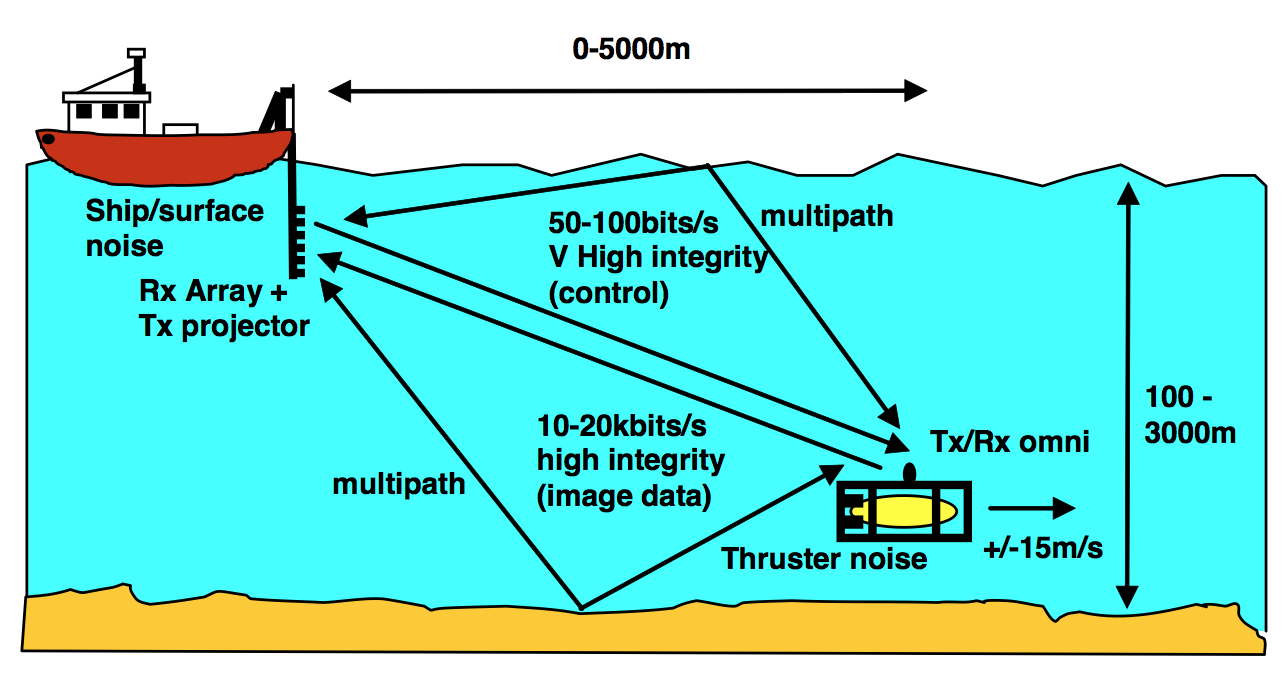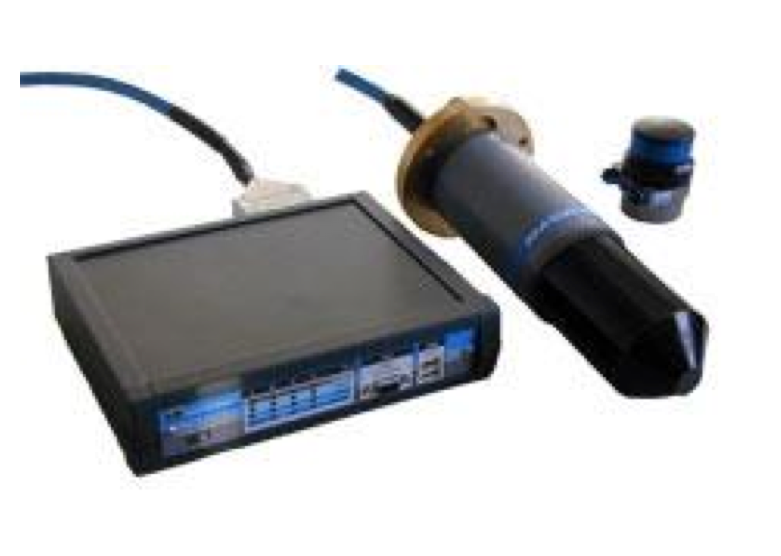Commercialisation of underwater acoustic communication and positioning technology
Submitting Institution
Newcastle UniversityUnit of Assessment
Electrical and Electronic Engineering, Metallurgy and MaterialsSummary Impact Type
TechnologicalResearch Subject Area(s)
Information and Computing Sciences: Data Format
Engineering: Electrical and Electronic Engineering
Technology: Communications Technologies
Summary of the impact
The commercialisation of Newcastle University's pioneering research in
underwater acoustic communication has created market leading products,
achieving economic impact, enhanced subsea operations, an award for
improved diver safety and reduced impact of subsea acoustic emissions on
marine mammals. Our research outputs have been incorporated in a range of
products manufactured under licence by Tritech International Ltd. Since
2008 the MicronNav product has become the preferred solution for tracking
underwater remotely operated vehicles from manufacturers including
Seabotix Inc and Videoray Inc, with over £2M of licensed products sold to
date. Bespoke high performance data telemetry systems have also enabled
previously impossible subsea operations to be completed.
Underpinning research
Due to the absorption of radio waves in water, the subsea industry relies
on acoustic signalling for wireless communication and navigation.
Underwater acoustic modems transfer digital data between underwater
equipment and surface vessels/platforms. Early modem designs employed
simple analog technology which was unable to meet industry demands for
data rate, range and reliability. Such systems failed to address the
extreme multipath/reverberation, noise and Doppler effects encountered in
the underwater channel, typically 100-10,000x greater in magnitude than in
radio communications. The research underpinning these improved products
was performed from 1994-2005 by Prof Oliver Hinton, Prof Bayan Sharif and
RA Jeffrey Neasham.

During work funded by G1, the team introduced bandwidth efficient, phase
shift keying modulation where less efficient schemes such as frequency
shift keying had previously dominated, increasing data throughput by an
order of magnitude. This was enabled by the development of sophisticated
adaptive receivers [P1][P5], employing arrays of receiving transducers, to
overcome the multipath/reverberation problem. These innovations led to
reliable transmission at data rates of the order of 20kbits/s through
severe multipath channels spanning hundreds of symbols and with rapid
fluctuations in path amplitude and phase. Understanding of underwater
adaptive array receivers was further enhanced during G2 and G5-7, leading
to the demonstration of very long range, multi-user networks [P2].
During G3 and G4, the group then developed novel algorithms to estimate
and remove the extreme Doppler effects occurring with moving platforms and
which previously led to loss of synchronisation. A journal article on this
subject remains one of the most cited references in the field of
underwater communication with 187 citations [P3]. The later development of
closed-loop tracking techniques allowed synchronisation to be maintained
between highly dynamic platforms such as small robotic underwater vehicles
and naval submarines [P4] with Doppler shifts of 1-2%.
The robust signals designed for synchronisation were then adapted to form
an extremely reliable, spread spectrum communication system for low bit
rate command/control applications. This is able to operate with SNR as low
as — 10dB (noise power is 10 times higher than the received signal power).
Furthermore, by virtue of its broadband signal correlation, the same
hardware was able to deliver range and direction information accurate to
10cm and 1 degree respectively.
From 2003 onwards the group collaborated with Tritech to develop a number
of high performance demonstrator systems based on the above technologies,
including modems for:
- The ALIVE autonomous intervention vehicle, achieving a world first by
carrying out maintenance on a 500m deep installation entirely by
acoustic communication of commands, video and sonar data.
- The Halliburton Geosub Autonomous Underwater Vehicle for subsea
geological surveying.
- The continuous reception of current meter data in a shallow estuary
channel, with busy shipping traffic, where acoustic emissions had to be
limited due to concern over harbour porpoise populations [P5].
References to the research
Peer reviewed publications: (Key publications are P1, P3
and P4)
P1. Neasham JA, Thompson D, Tweedy AD, Lawlor MA, Hinton OR, Adams AE,
Sharif BS, Combined Equalisation and Beamforming to Achieve 20kbits/s
Acoustic Telemetry for ROVs, Proceedings of MTS/IEEE OCEANS, 1996,
Volume 2, pp 988 - 993. (21 citations) — This paper showed how high
data rate underwater transmission in severe multipath was possible.
P2. Thompson, D.; Neasham, J.; Sharif, B.S.; Hinton, O.R.; Adams, A.E.;
Tweedy, A.D.; Lawlor, M.A.; Performance of coherent PSK receivers
using adaptive combining, beamforming and equalisation in 50 km
underwater acoustic channels , Proceedings of MTS/IEEE OCEANS '96,
Volume: 2, 1996 , pp 845 - 850. (21 citations)
P3. Hinton OR, Neasham J, Sharif BS, Adams AE, A Computationally
Efficient Doppler Compensation System for Underwater Acoustic
Communications, IEEE Journal of Oceanic Engineering, 25, No 1,
52-61, 2000. (187 citations) — This publication showed how
synchronisation could be maintained under severe Doppler effects with
moving platforms.
P4. Sharif BS, Neasham JA, Hinton OR, Adams AE, Davies J, Adaptive
Doppler Compensation for Coherent Acoustic Communications, IEE
Proceedings on Radar, Sonar and Navigation 2000, 147(5) (26 citations).
— This paper showed how receivers could tolerate high acceleration
platforms and defined a technique used today in Tritech modems and UK MoD
systems.
P5. Paul A Van Walree, Jeffrey A Neasham, Marco C Schriver, Coherent
Acoustic Communications in a Tidal estuary with Busy Shipping Traffic,
Journal of the Acoustical Society of America 2007, 122(6), 3495-3506.
Funding
G1. High Data Rate Sub-Sea Acoustic Communications for UUVs (TUUV1),
EPSRC GR/H85281/01, November 1992 — October 1994, £123,856.
G2. Long Range Acoustic Communication (LORACOM) , EC, 1994 - 1996,
£160,000
G3. Robust Bidirectional Communications for UUVs (TUUV2), EPSRC
GR/L11670/01, May 1997 — Sept 1999, £187,703.
G4. Doppler Tolerant Receiver, DERA funded project, July 1998 — Dec 2000,
£120,000
G5. Long Range Telemetry in Ultra-Shallow Channels (LOTUS), EC, Oct 97 —
Jan 01, £1.2M.
G6. Shallow Water Acoustic Networks (SWAN), EC, Dec 1997 — Nov 2000,
£300,000
G7. Acoustic Communication network for Monitoring of underwater
Environments in coastal areas (ACME), EC FP5, Dec 2000 — Nov 2003,
£250,000
Details of the impact
"Newcastle's research on underwater acoustic technology has had a
strong and lasting impact on Tritech's business and the subsea industry
as a whole, reaching the offshore oil & gas industry, oceanographic
data collection, renewable energy, search & rescue and professional
& recreational diving." — Technical Director 1990 - 2009,
Tritech International [E5].
Impact on business
A licence agreement and Knowledge Transfer Partnership with Tritech has
directly resulted in 3 innovative products being marketed by the company
since 2008. The first two of these were the micron data modem [E2, E5] and
MicronNav USBL tracking system [E3,E5] which incorporate Newcastle's
Doppler tolerant spread spectrum signalling and range/angle estimation
algorithms. These products now provide tracking for the majority of
miniature underwater vehicles being sold worldwide. Over 300 licences have
been issued by the University to date with a sales value of £2M. The
market for these devices is growing rapidly, currently accounting for
around 10% of company turnover in a business employing ~100 people.
The most recent product introduced is the high performance AM400 acoustic
modem [E4, E5] which incorporates all of the underpinning research outputs
and has demonstrated unparalleled performance in terms of data rate (up to
32kbits/s) and range (up to 10km). This has enabled the company to win
contracts for high value bespoke systems, to operate in very severe
channel conditions where competing products are completely unable to
operate, and the university has issued 6 licences corresponding to around
£300k of sales since 2010. These products represent major steps forward in
performance, miniaturisation and cost, which wouldn't have been possible
without Newcastle's innovative signal processing [E5].

Impact on the subsea industry
The MicronNav USBL and micron modem products have provided a reliable,
cost effective and miniaturised solution for the tracking of small
underwater robotic vehicles. This is now the preferred solution
adopted by vehicle manufacturers such as Seabotix Inc [E6] and Videoray
Inc who account for the majority of the world market. Many end
users, including the US and Canadian Navy [E7], have found the ability to
accurately track these vehicles invaluable in rapidly locating and/or
tagging seabed targets. The combination of accurate tracking and data
communication in one miniature unit has also led to its deployment on
several autonomous underwater vehicles under development around the world
[E8]. Likewise high performance AM400 modems delivered by Tritech have
enabled very challenging operations to be carried out. A good example of
this is the remote collection of large data files from subsea tidal
turbine near Orkney, overcoming severe noise and wake effects and a
hostile 5km shallow water channel.
Impact on diver safety
Inspired by the death of a well known diver, the IET and the British Sub
Aqua Club (BSAC) launched an international competition to challenge
engineers to develop an affordable system to track and monitor the world's
estimated 3 million divers. The Newcastle group and Tritech teamed up to
develop low cost prototypes for a diver personal transponder and surface
interrogator based on the successful spread spectrum concepts. 4 teams
from around the world entered devices but, after successful trials by BSAC
divers in Scotland, the Newcastle-Tritech design was declared the winner
[E9] and the team were presented with an award and prize money by the IET.
BSAC described this as one of the most significant contributions to
diver safety in the last 50 years and could help to reduce the estimated
100 deaths each year in diving accidents. Since 2008 Tritech have
delivered several systems for diving applications, enabling multiple
divers to be tracked from the surface, to receive commands and to signal
if they get into difficulty. Working with another commercial partner, a
mass market product accessible to all recreational divers is undergoing
final testing at the time of writing ahead of a product release.

Impact on the environment
Another positive impact brought about by the research is the reduced
impact on marine life, since some environmental groups estimate that up to
10 million whales/dolphins are affected by high power acoustic systems per
year. Both the spread spectrum technology and the adaptive array receivers
dramatically reduce the required acoustic source power for a given range.
The AM400 product emits a total acoustic power of approximately 10W
which is up to 10 times lower than competing systems intended for the
same range. Similarly the Micron modem and USBL products may operate
over 1km radius without exceeding the safe limit on acoustic intensity
suggested by marine biologists of approximately 100mW/m2.
Sources to corroborate the impact
E1. 2007 Licence agreement between Newcastle University and Tritech
International Ltd.
E2. http://www.tritech.co.uk/product/micron-data-modem
— specification sheet for micron data modem product.
E3.
http://www.tritech.co.uk/product/usbl-tracking-system-micronnav —
specification sheet for MicronNav tracking system.
E4. AM400 acoustic modem data sheet, Tritech International, 2010.
E5. Corroborating statement from Technical Director, Tritech
International Ltd.
E6. Corroborating statement from Senior Vice President of Seabotix Inc.
E7. http://www.seabotix.com/about_seabotix/news/news12/rimpac.htm?story_link=email_msg
— documentation of the MicronNav USBL system being applied in underwater
vehicle trials by the Canadian Navy
E8. http://www.fer.unizg.hr/zari/labust/equipment/auv
— description of micron modem product deployed on autonomous underwater
vehicle (htm supplied).
E9. http://www.bsac.org/news.112.htm
— article on the final of the IET/BSAC Divetrack competition.